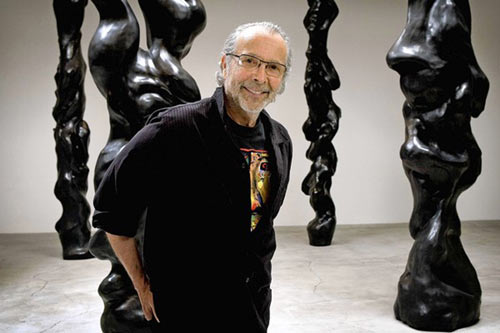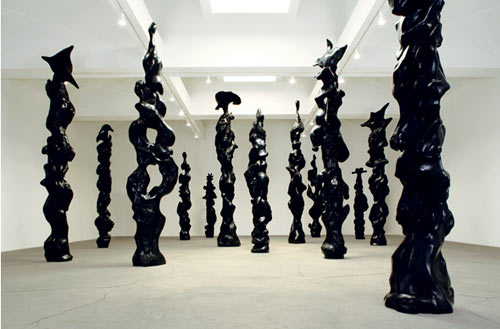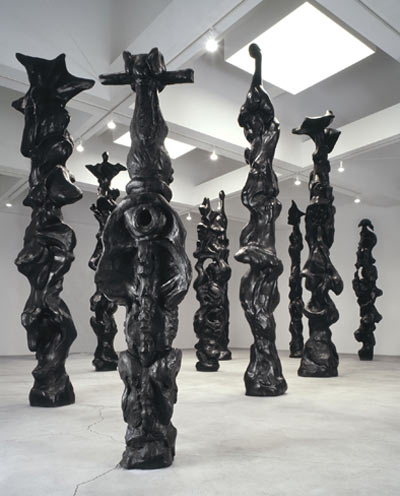
 Sculpture News at SculptSite.com
Sculpture News at SculptSite.com
Herb Alpert Sculpture |
| The Los Angeles Times By Scarlet Cheng Standing in a forest of sinuous, black totems spiraling into the lofty heights of the main room at Ace Gallery Beverly Hills, Herb Alpert is surrounded by an art form he has practiced for the last two decades - sculpture. By his account and that of those who know him, he's a man who lives on the right side of his brain - he percolates on the creative and the intuitive. "I do something every day, whether sculpting or painting," he says. "It definitely feeds my spirit when I sculpt or paint or blow the horn, that's an essential part of my being." He also believes that others should have a chance for self-expression through the arts, as well as positive standards of living, and to that end he has given away nearly $100 million over 20 years. At 75, his art practice and his arts philanthropy keep him busy. Just this spring, he read an account of the imminent demise of the venerable Harlem School of the Arts because of lack of funding. Since the early 1960s the New York institution has provided training in music, dance, theater and the visual arts to mostly underprivileged kids. Alpert quickly called Rona Sebastian, the head of his foundation. "Unbelievable," he said, and set her to seeing what they could do about it. She approached New York's Department of Cultural Affairs, and in two weeks the Herb Alpert Foundation was able to offer a half million dollar matching grant - it saved the school. Yes, he's the man better known for wielding his trumpet, mellifluously leading the Tijuana Brass in the 1960s in such tunes as "A Taste of Honey" and "What Now My Love." When Alpert was 8, he picked up the trumpet and knew it would be his musical partner for life. The painting came some two decades later. "When I was touring in the '60s with my group, I used to go to museums," he recalls. "It seems like I was always going to the Modern art section." A low-key, soft-spoken man, he sports combed back gray hair and a light beard, and wears a black T-shirt he has hand-painted. "I had a feeling I might move some paint around and have a good time," he says. "I started with acrylics. I wasn't crazy about the smell of oil paints, and I wanted to work quicker." He was naturally drawn to abstract forms, and he picked up some technique from his friend artist Les Biller. Biller gave him valuable advice - he thought his paintings were too "center-conscious." "And it kind of freed me," he says. This need to keep moving, ahead or in different directions, seems to pump Alpert's creative juices. As he continued to paint, he also became interested in making three-dimensional work. Twenty years ago he learned from sculptor Kristan Marvell how to handle clay. "Once I put my hand on the clay, I was hooked," he says. "It's a very sensual feeling, you can work very quickly if the clay is cooperating." First he made small pieces a few inches tall, then he made pieces several feet tall. "I had people help me build the armature," he says, "but I would work the clay myself." All this began in his kitchen, he says with a laugh, "which my wife wasn't crazy about." Especially when he used a blowtorch to soften wax pieces. His wife is singer Lani Hall, with whom he released an album last year, "Anything Goes: Herb Alpert & Lani Hall Live." He also has an album coming out this fall, "I Feel You." "When I ran out of space in the kitchen, I realized I needed a studio," he says. They built one on their property in Malibu. "And we're running out of space there. I just rented a storage space where I could put my molds." The works in "Black Totems," the current show, are made of bronze coated with a soft black patina, and reach up to 18 feet high. They are cast at a local foundry and require several molds each. Alpert has been making these "totems" for a decade. He was inspired by seeing totems created by Native Americans of the Pacific Northwest, and also by the tall, gnarly "scholar's rocks" prized by traditional Chinese literati, such as those in the Chinese Garden at the Huntington. "There was a progression, I started making them larger and larger," he says. "As they go up, there are parts I change from the original concept. I like to keep that spontaneity - to me it's like jazz." While his sculptures are abstract, they do suggest organic forms twisting in space, segments piled atop one another. "[E]ach one is an aspiration toward the heavens," critic Peter Clothier recently wrote in the Huffington Post, "an expression of the enduring, deeply human need to be one with nature and our fellow-travelers on this planet, and at the same time to integrate with some power beyond our fragile, temporal existence." Alpert is reluctant to say what he sees in the work, not wanting to influence how others see. However, several are topped with distinctly bird-like forms, perched or about to take flight, and as his eye looks around, he admits, "Here's the head of a double bass fiddle, and this one is called the maestro, the conductor of the orchestra." Writing checks Such creativity and intuition have also guided Alpert's philanthropy, which is exercised through the Herb Alpert Foundation. Two years ago, Parade magazine published the Giving Back Fund's rating of celebrity generosity - Alpert was ranked second ($13 million in annual giving), after Oprah Winfrey ($50 million) and ahead of Barbra Streisand ($11 million). For Alpert, that generosity comes naturally. "I feel that giving is a breeding ground for receiving," he says. Although the foundation was established in 1988, president Sebastian says it really got off the ground a couple years later; 1990 is also the year he and business partner Jerry Moss sold A&M Records to Polygram for a reported $460 million. In 1962 they had founded A&M to produce albums for the Tijuana Brass; the company also successfully took on a slate of other talents including the Carpenters, Cheech and Chong, Joan Baez and Janet Jackson. When they sold the business, A&M was the largest independently owned record label in the world. |
 I had no idea about the philanthropic side of Herb Alpert. His music sounds all the the better now and the sculpture is not to bad either! Thank you Herb Alpert for all your support to the arts community. |
 Musician, businessman, philanthropist and sculptor Herb Alpert, photographed at Ace Gallery Beverly Hills. (Ricardo DeAratanha, Los Angeles Times / June 29, 2010) |
 |
 |
The foundation is located in Santa Monica, sharing a modest-sized building with some of the founder's other enterprises. His paintings - colorful abstract works made with bold swatches of paint - dot the walls. Sebastian oversees a small, tightly-knit staff. Their grants fall into two main categories - arts and arts education, and compassion and well-being. In the last four years under her watch, they've given away $10 million to $20 million a year. That's included grants to institutions such as UCLA to organize its music program under the Herb Alpert School of Music and to the California State Summer School for the Arts to help run their summer program at CalArts. Every year five individual artists and performers are selected for the Alpert Award in the Arts, which comes with a $75,000 grant. According to the program's 2009 brochure, the award is given to "experimenters who are challenging and transforming art, their respective disciplines, and society." Last year that included video artist Paul Chan, composer-musician John King and choreographer Reggie Wilson. "We're a proactive foundation," Sebastian says. "Some foundations have guidelines and wait for people to apply. We go out and seek projects we think need to be funded." One major Los Angeles arts institution, P.S. Arts, grew out of a chance meeting between Alpert and Paul Cummins, then headmaster of Crossroads School in Santa Monica. They were at a potluck dinner for parents and commiserated over the stripping away of arts education from public schools. "Herb was appalled and said, 'Is there something we can do about it?'" recalls Cummins, who already had ideas for a model program. The Alpert Foundation pitched in with a grant for $600,000 over three years. That launched P.S. Arts at Broadway Elementary in Venice, the first of 22 schools where they would establish a weekly arts curriculum. That number includes seven schools in the Lawndale elementary school district and eight in LAUSD. Later came more aid totaling $3.1 million, and the Foundation will soon be announcing a grant to help them go the next step: to establish an endowment. "He's one of the more extraordinary men I've ever met," says Cummins, now running his own foundation. "Not only his generosity, but his willingness to take risks, and to look at a problem and say, Let's fix it.'" The CalArts Community Arts Partnership has been another recipient of Alpert's generosity. The program sends CalArts students, led by teachers and alumni, into 60 neighborhoods across L.A. County to teach the visual and performing arts. "I believe it was in 1992 that Alpert visited our jazz and world music program at the Watts Tower," says Glenna Avila, CAP's director. "We were training young high school students, and his initial scholarships helped students come to CalArts." Avila praises the foundation for being responsive to their needs. "They are now involved in program support, and they gave us a huge challenge grant in 2008 - they offered $1 million to help build our endowment." "I just have to say," she adds, "what better way of leaving a legacy than assisting young artists in pursuit of their artistic dreams?" Alpert himself is modest about his philanthropy - in this instance anyway, he lets others toot his horn. "I want to give back - I've been awfully blessed," he says quietly. "I had the opportunity to spread my good fortune and I wanted to do that in a very conscious way." |
More Sculpture News ....
Submit your SCULPTURE NEWS.
It's easy, just send us an e-mail
(click on Submit News in the left menu) with your pertinent information along with images, we'll take care of the rest. Sculpture makes our world a much better place in so many ways!
SculptSite.com, along with Sculptors and their creative genius all helping to bring the beauty and message of Sculpture to a hurried world.

